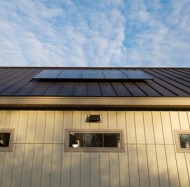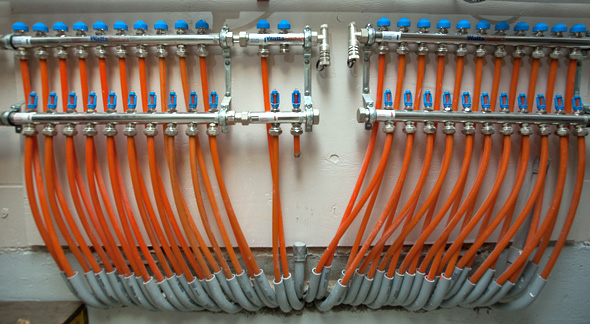
In 2012, the Yarmouth Water District moved into a new, 10,000-square-foot building at 181 Sligo Road. The superintendent and board of trustees worked closely with a neighborhood group to address concerns regarding aesthetics and building efficiency. With its barn-style shop and storage yard there is ample room for YWD vehicles, as well as the safe storage of pipes, hydrants, and other materials. The site borders the Royal River, and that portion of the land is protected by a conservation easement, providing access to the public.
“The Yarmouth Water District building is a wonderful example of the town and community working together. A building that complements its neighbors in both scale and aesthetics was considered preferable to an anomalous industrial structure, hidden from view behind berms. The farmhouse design reflects the rural residential character of Sligo Road.”
Vanessa Farr, CNU-A
Director of Planning & Development
Leadership in Energy and Environmental Design
 The facility was built to LEED (Leadership in Energy and Environmental Design) sustainable building standards. It is exclusively powered by green energy sources and the total electrical use per square foot is well below that of a standard building. It is also the first municipal building in Yarmouth to earn LEED certification. All water used for meter testing—more than 50,000 gallons annually—is captured and reused by the YWD for washing vehicles and irrigation. Water conserving bathroom fixtures also reduce the volume of water going to the town’s treatment facility. Radiant floor heating is powered by a high efficiency, propane-fired steam boiler.
The facility was built to LEED (Leadership in Energy and Environmental Design) sustainable building standards. It is exclusively powered by green energy sources and the total electrical use per square foot is well below that of a standard building. It is also the first municipal building in Yarmouth to earn LEED certification. All water used for meter testing—more than 50,000 gallons annually—is captured and reused by the YWD for washing vehicles and irrigation. Water conserving bathroom fixtures also reduce the volume of water going to the town’s treatment facility. Radiant floor heating is powered by a high efficiency, propane-fired steam boiler.

 A geothermal system cools the building in the summer and heats the makeup fresh air supplied to the building. Solar panels on the roof are capable of producing 3.7 kW under ideal conditions. They have already exceeded the goal of providing five percent of the building’s electricity needs. In peak sunshine the panels produce more power than the building can use. The District sends the excess power (40–48 kW per month) back to the grid for a small credit. Energy not produced by the District is purchased through Maine Power Options and is produced from certified green sources.
A geothermal system cools the building in the summer and heats the makeup fresh air supplied to the building. Solar panels on the roof are capable of producing 3.7 kW under ideal conditions. They have already exceeded the goal of providing five percent of the building’s electricity needs. In peak sunshine the panels produce more power than the building can use. The District sends the excess power (40–48 kW per month) back to the grid for a small credit. Energy not produced by the District is purchased through Maine Power Options and is produced from certified green sources.

